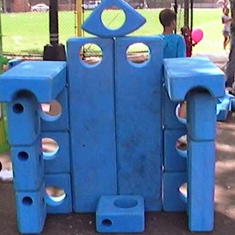Above: Symmetry can result from the physical requirements of balance or support.
Here you see how this child bisects the long tube with her grasp so that it balances in a horizontal orientation as she rocks.

The symmetry of stacked arches results primarily from the physical requirement of two supporting pillars.

The children make a three-sided, chair- like structure. The “armrests” use the same motif on the right and the left separated by the width of the structure. The “head piece” at the back bisects the back of the chair. Everything is symmetrical.
What It Means
Children have a natural tendency to make structures symmetrical, first because of physical balance and later because of visual balance. Some research suggests that the symmetrical structures children make embody a form of mathematical thinking, i.e. this side equals that side. This happens first by placing two identical blocks side by side, then by bisecting a long block by placing a short one in its middle, and later by placing two small blocks on either side of a larger block (i.e. “bookends’). Sometimes the bookends are themselves complicated motifs of three or four blocks in equivalent arrangements. These structures require more planning and pattern analysis.
Children of Different Ages
In terms of words children use to talk about the world, younger children actually over- emphasize visual symmetry. For example, a three year old, when asked to explain what balance means after just walking down an I-beam, said, “Holding your arms out like that,” (outstretched like a T). The child treats the visual symmetry as the best description of his balancing, rather than the tiny adjustments he made while walking the beam.
This material is adapted from the publication “Imagination Playground’s Guidance to Play” by George E. Forman, PhD, Emeritus Professor, University of Massachusetts (Amherst) and President of Videatives, Inc.
Dr. Forman has over 33 years of experience in university teaching, cognitive research, multimedia design and educational consulting in the area of early childhood learning and development.
“Guidance to Play” covers 20 topics that help illustrate the significance in what children are doing as they play as well as concrete actions Play Associates can take to facilitate positive behaviors.



